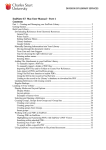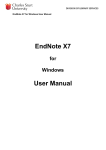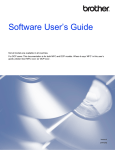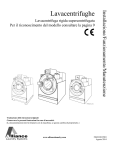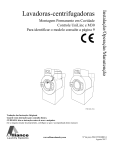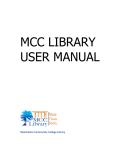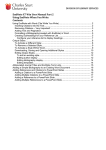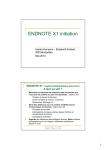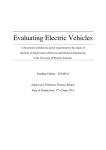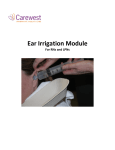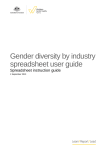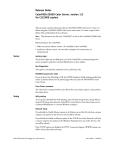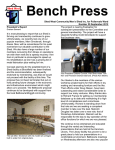Download EndNote X7 User Manual - Charles Sturt University
Transcript
DIVISION OF LIBRARY SERVICES EndNote X7 Mac User Manual EndNote X7 for Mac User Manual Table of Contents Where Can I Get Help With EndNote? .................................................... 4 Part 1 – Creating and Managing your EndNote Library ............... 5 Getting Started ........................................................................................ 5 Build your Library .................................................................................... 6 Downloading References from Electronic Resources. ............................................ 6 General Tips................................................................................................................... 6 Primo Search ................................................................................................................. 6 Editing EndNote Filters ................................................................................................... 9 Library databases ..........................................................................................................10 Google Scholar .............................................................................................................13 Manually Entering Information into Your Library ................................................... 14 Moving through the document window ..........................................................................15 Term Lists and Auto Suggest ........................................................................................15 Tips for choosing the right reference type ......................................................................16 Entering author names ..................................................................................................16 Entering Dates ..............................................................................................................17 Adding File Attachments to your EndNote Library ................................................ 18 To manually import a PDF file: ......................................................................................19 To manually import a folder of PDF files: .......................................................................20 Importing PDF Files and/or Folders to Create New References ....................................20 Auto-import of PDFs and EndNote groups ....................................................................21 Using Find Full text function to import PDFs ..................................................................21 Using the DOI in the record to Find Full text ..................................................................22 Linking to the record in the Library’s databases to download the PDF ...........................22 Updating References with missing content ........................................................... 22 Regular Backups................................................................................................... 23 Looking At Your Library ......................................................................... 23 Display Modes and Layout Options ...................................................................... 24 Display Modes ...............................................................................................................24 Layout options ...............................................................................................................24 Examples of layout views ..............................................................................................25 Selecting and Opening a Reference ..................................................................... 29 Creating Groups, Groups from Groups and Group Sets ...................................... 29 Creating a new group ....................................................................................................29 Creating group sets .......................................................................................................30 Creating groups from Groups ........................................................................................31 Smart groups.................................................................................................................32 Working with your PDFs in EndNote ..................................................................... 32 Viewing PDFs in EndNote .............................................................................................32 Highlighting and Annotating PDFs with EndNote’s PDF Viewer.....................................32 Searching within attached PDFs....................................................................................33 Searching Any Field + PDF ...........................................................................................33 To search within a specific PDF ....................................................................................34 Using EndNote’s record numbers to file printed documents ................................. 34 2 Part 2 – Using EndNote When You Write ..................................... 35 Using EndNote with Word (Cite While You Write) ................................. 35 Inserting Citations into the Text ............................................................................. 36 Removing Citations – Very Important! .................................................................. 37 Adding text and pagination.................................................................................... 38 Formatting a Bibliography (created with EndNote) in Word .................................. 39 Creating Subheadings for your Reference List ..................................................... 40 Configure your Reference list to display headings .........................................................41 Output Styles ........................................................................................ 42 To Activate a Different Style .................................................................................. 42 To Remove a Selected Style: ................................................................................ 43 Activate a style within Word .................................................................................. 43 Downloading, Saving and Opening Additional Styles ........................................... 43 Editing Output Styles ............................................................................................ 44 To edit an existing style .................................................................................................44 Editing In-text Citation display .......................................................................................45 Editing Author display ....................................................................................................45 Editing Bibliography display ...........................................................................................46 Editing templates ...........................................................................................................46 Abbreviated Journal Titles and EndNote Term Lists .............................. 48 Adding a Simple Bibliography to an Existing Word Document. .............. 48 Part 3 – Using EndNote on More Than One Computer ............. 49 Using an External Drive to Hold you EndNote Library .......................................... 49 Syncing your EndNote Library .............................................................................. 49 Syncing with EndNote Online ........................................................................................49 How to delete duplicate records after syncing with EndNote Online ..................... 51 Syncing your EndNote Library on a 2nd computer ................................................. 52 Sharing Records with Colleagues ......................................................... 52 Copy and Email Records from your EndNote Library ........................................... 52 Creating a compressed Library File ...............................................................................52 Restoring a compressed Library File .............................................................................53 Document Groups .........................................................................................................54 Sharing Groups Using EndNote Online ................................................. 55 To Create a New Group to Share: ........................................................................ 55 How to Share a Group .......................................................................................... 55 Importing Records From a Colleague’s Shared Group ......................................... 55 Adding Records to a Colleague’s Shared Group .................................................. 56 3 Where Can I Get Help With EndNote? The Help menu within Endnote: A useful and recommended resource. The CSU Library’s Endnote Library Guide: http://libguides.csu.edu.au/endnote Any training videos, patches, or changes to the training notes are listed here, as well as frequently asked questions. Endnote FAQs and Blog: Someone else has probably had the same problem, so why not check the FAQs & Help tab in the Library’s EndNote Guide http://libguides.csu.edu.au/aecontent.php?pid=539394&sid=4436797 Or keep up to date with the blog? http://Endnoteblogcsu.blogspot.com/ Ask your friendly Faculty Liaison Librarian: http://www.csu.edu.au/division/library/research/faculty/ Faculty liaison librarians are based at the Albury-Wodonga, Bathurst, Orange and Wagga Campuses to support academic staff, researchers and postgraduate students. Book-A-Librarian for some training (academic staff, researchers and postgraduate students only): If you would like more training, then book a session with one of your Faculty Liaison Librarians. Complete the form found at: http://csu.altarama.com/reft100.aspx?key=ask_copy4&ref=120 The Thompson & Reuter’s Online User Guide: Thompson & Reuter’s EndNote Online User Guide is available from the EndNote website http://endnote.com/if/online-user-manual/x7 The Endnote website: http://www.Endnote.com/ You can download new or updated output styles from this website and view online tutorials. 4 Part 1 – Creating and Managing your EndNote Library Getting Started These training notes assume that you have installed EndNote into your Applications folder. 1. Open the Applications folder 2. Click on the EndNote X7 folder 3. Click on the EndNote X7 application icon 4. The first time you start the software, you will see the EndNote customizer screens. Click on Next several times, and then Done 5. EndNote displays a welcome screen showcasing the features of X7 If you are upgrading EndNote from a previous version, and you already have an EndNote library, your EndNote library will automatically open. If you have never used EndNote before, a new EndNote library called “My EndNote library” will be created for you and saved in the Documents folder. The new library appears as an empty EndNote library, showing “0 of 0 references” 5 Build your Library Downloading References from Electronic Resources. General Tips Information from electronic resources, such as the Library discovery tool; Primo, and other information databases and Google scholar can all be exported into your EndNote Library. Primo Search Items found using Primo can be exported to EndNote, both individually and as a group. As with all exports it is important to check your references in your EndNote library as some editing may be required. Safari users note: Safari does not recognise the direct export command from Primo as files it can import. See the note after step 5 for further instructions on exporting Primo search results into EndNote using Safari or Firefox. Individual References 1. Login to PRIMO and do your search as normal 2. Open the Details tab 3. Click on the Send To tab 6 4. Choose EndNote (RIS) 5. Import to Citation Manger box will appear, it will default to UTF-8 , click Ok For Safari users: At this point Safari will download a file named Primo_RIS_Export.ris 1. Drag and drop the downloaded file to the EndNote application icon on the Dock 2. EndNote will open (if it is not already) and the file will automatically import. EndNote should import the file into your current library. If you are asked to choose a Reference Library, use the Open Reference Library window to find and click on your EndNote library For Firefox users: The first time you do this, Firefox will present you with an “opening delivery” window: 1. 2. 3. 4. 5. 6. Click on Open with Click on Choose Find the EndNote application icon in your Applications folder Click on the EndNote icon Click on Open Click the box next to Do this automatically and click on OK. You should not need to do this process again EndNote should offer to open your current library. If it doesn’t, use the Open Reference Library to find and click on your EndNote library file The reference will be added to your most recently opened EndNote Library. 7 Multiple References 1. Login to PRIMO and do your search as normal 2. Choose your references, select Send To tab and Add To My Folder 3. Do this for all the references you would like to add to EndNote. 4. In the top right click My Folder 5. Select the references you would like to add to EndNote 6. Click on the Send To tab 7. Choose EndNote (RIS) 8. Import to Citation Manager, it will default to UTF-8 and click Ok 8 Safari users note: Safari does not recognise the direct export command from Primo as files it can import. See the instructions on page 13 on exporting individual references for further information. WARNING! There are a few things to note when using PRIMO to export to EndNote: For books – all authors and editors come across into the Author field, so some editing may be required for edited books. Corporate Authors – records that include corporate authors can be made to export with the appropriate comma, the normal filter will not include this. If this is something that you regularly export, you can edit the filter, see below for more instructions. Otherwise you can edit the record. Editing EndNote Filters To change the import of Corporate Authors to include a comma, you will need to go into the EndNote program. Click Edit, Import Filters If you have been using the RefMan RIS filter it will be listed and you can click “Edit RefMan RIS” if not, choose New Filter and then choose RefMan RIS from the list of options, then click Edit. 9 Once you are in the filter, choose the Author Parsing option and under the Last & First Names: click on the drop down menu and change from Smart to Import As Is. If you have any difficulties, contact a Faculty Liaison Librarian for assistance. Library databases You can search the databases from the CSU library webpage, and then export the search results to EndNote. Safari users note: Safari does not recognise the direct export command from database searches as files it can import. See the note after step 7 for further instructions on exporting search results from Safari and Firefox into EndNote. Within the Ebsco databases, you can export citations from the results screen as shown below: 10 1. Click on the Add to folder icon to save your reference to a folder. You can also select a range of references with one click – look for the link to add all of the displayed records at once. 2. Go through the pages of results selecting all of the relevant articles. 3. Click on Folder view link. 4. The saved items will be listed. You will need to select All again 5. Click on the Export option. 6. Ebscohost is preset to do a Direct Export to EndNote, Procite or Reference Manager 7. Click on Save 11 For Safari users: 1. At this point Safari will download a file name ‘Delivery’, (or “Save records” from the Informit databases, or “ovidweb.cgi” from the OVID databases) Variously named files that will be downloaded from the databases 2. Drag and drop the downloaded ‘delivery’ file (or other named file) to the EndNote application icon on the Dock 3. EndNote will open and prompt you to select a Library in which to import the files 4. Choose the Library and references will automatically import. For Firefox users: Note: The first time you do this, Firefox will present you with an “opening delivery” window: 1. 2. 3. 4. 5. Click on Open with Click on Choose Find the EndNote application icon in your Applications folder Click on the EndNote icon Click on Open 12 6. Click the box next to Do this automatically and click on OK. You should not need to do this process again EndNote should offer to open your current library. If it doesn’t, use the Open: window to find and click on your EndNote library file The references will be transferred to your library in an “Imported references” temporary group. This is to enable you to evaluate and modify the new records before looking at your entire library Google Scholar Safari users note: Safari does not recognise the direct export command from Google Scholar searches as files it can import. See the note after step 4 for further instructions on exporting search results from Safari and Firefox into EndNote. To set Google Scholar Settings, 1. Click on the Settings option in the top right of the page. 2. Click on Bibliography Manager = Show links to import citations into EndNote, and Save these settings. 13 3. Locate required reference in Google Scholar 4. Click Import into EndNote link displayed below each record in Google Scholar search results For Safari users: At this point Safari will download a file named ‘scholar.enw’ 1. Drag and drop the downloaded file to the EndNote application icon on the Dock 2. If asked, choose a Reference Library to import the reference into 3. Click OK For Firefox users: Note: The first time you do this, Firefox will present you with an “opening scholar.enw” window: 1. 2. 3. 4. 5. 6. Click on Open with Click on Choose Find the EndNote application icon in your Applications folder Click on the EndNote icon Click on Open Click the box next to Do this automatically… and click on OK. You should not need to do this process again EndNote should open your current library and import the reference. If it doesn’t, use the Choose a Reference Library option to navigate to your EndNote Library. The references will be transferred to your library in an “Imported references” temporary group. This is to enable you to evaluate and modify the new records before looking at your entire library Manually Entering Information into Your Library Sometimes you will have references that need to be added manually or you may need to modify an imported reference. Make a new reference in your library by Clicking on the References menu and clicking on New Reference Using the Cmd (⌘) + N short cut or 14 Clicking on the New Reference icon in the top header The default new record is a Journal article reference type. If you need to create a record for a different type of item, choose a reference type from the dropdown list at the top of the window. If you change the record type, the fields will alter to match the information needed to reference the new type. Enter bibliographic information into the appropriate fields in the Reference window. You may not need to enter information in all the available fields. When you are finished, close the reference to save it and add it to the library. Moving through the document window Use the scroll bar to look at the fields, which may change according to the needs of the reference type. The active field is surrounded by a border. Press the Tab key to select the next field in the reference. Press Shift + Tab to select the previous field. ‘Next Reference’ and ‘Previous Reference’ buttons at the top of the reference window allow you to browse references in a library. Closing a reference: Click on the close box or press Command + W to close a reference and save any changes. Special bibliographic formatting and punctuation should not be included when you enter reference data into EndNote. For example, you do not need to put quotes around titles, italicise journal names, or include the abbreviation ‘Vol.’ along with volume numbers. Enter only the raw data and leave the formatting to EndNote. Term Lists and Auto Suggest As you enter new references into your library, EndNote notes any new terms that are typed into the Author, Journal, and Keywords fields. New terms are indicated in red text. EndNote saves these and will auto-suggest them when you enter anything similar, to save you some typing. 15 Tips for choosing the right reference type Use Book Use Edited Book Use Book Section Use Conference Proceedings Use Conference Paper Use Journal Article Use the Web Page Use Personal Communications Use Chart/Table For books written by one or more authors for books edited by one or more editors (whether they are books in a series or not). For references to parts of edited or nonedited books (a chapter, for example, or one article in published conference proceedings). For unpublished proceedings For articles that are published as part of the comprehensive conference proceedings For journal articles that appear either online or in print. For citing material from a Web page or ftp site. For email discussions if you want to include an image and later insert that image as a table in Microsoft Word (Images in all other reference types will insert into Word as figures, which are listed and numbered separately from tables) Entering author names In general, entries with more than one author or editor must be entered one name per line. It is best to enter authors in the following order: <Family name><comma><space><First name><space><middle name or initial> e.g. Suzer, Max E. EndNote abbreviates first and middle names if required, so for maximum flexibility enter whole names whenever possible. If you are entering initials, type a period or a space between initials, (for example ‘Merrell, T.A.’ or ‘T A Merrell’), otherwise EndNote interprets the initials as a single name: ‘Ta.’ If a reference has no author, you should leave the Author field blank. Do not enter ‘Anonymous.’ EndNote will manage this according to the referencing style you choose. 16 The table below demonstrates how EndNote will interpret the author data that you enter. The names in bold indicate what EndNote will identify as the family name. Data Entered EndNote interpretation Data entered EndNote Interpretation Jones, Davey Davey Jones Zhang, Haiyuan Haiyuan Zhang Davey Jones Davey Jones Haiyuan Zhang Haiyuan Zhang van der Laar, Lianne Lianne van der Laar Lianne van der Laar Lianne van der Laar Department of Agriculture, Department of Agriculture Department of Agriculture Department of Agriculture Entering Dates The APA 6th manual states: “Do not include retrieval dates unless the source material may change over time (e.g., Wikis)” (American Psychological Association, 2010, p. 192). If you DO still need to enter a date, you can put the date in as: 28th July 2005 28 Jul 05 or 7/28/05 Note: If you want to use numbers only, you MUST put them in using the American style of Month/Date/Year. Choose one style and use it consistently, or the citations will look odd in a bibliography. 17 Adding File Attachments to your EndNote Library Each EndNote record has a File attachments field. EndNote makes a copy of the original file and places it in the DATA folder that is created with your EndNote database. EndNote library (.enl) and DATA folder You can attach a PDF to a record by 1. Selecting the record in your EndNote Library 2. Clicking on References in the top menu 3. Select File Attachments 4. Select Attach File and then locate the pdf or any file to attach to the record Alternatively you can drag and drop PDF and other file types into selected records in your EndNote Library. EndNote will always be able to access the file, even when you share your database with a colleague. Opening a PDF with EndNote’s PDF viewer There are a couple of different ways to open a PDF within EndNote 1. Double click on the reference that contains the PDF that you want to view: Layout options with PDF view selected The layout tab in the bottom right corner needs to be set to show PDF 18 2. With the main EndNote Library layout set to show any of the following views: “Right PDF”, “Right - Split” “Bottom- Split” or “Bottom - PDF”, click on the open PDF icon: “Right PDF” view with ‘open PDF’ option Note: if you attach Word or Excel files, please be aware that EndNote makes a copy of the original file and adds it to the .Data folder. Any changes made to the original file will not be saved to the copy in the .Data folder. Do not attach files that you haven’t finished modifying. Note: To open a PDF outside EndNote’s PDF viewer, choose Option+Command+P and the PDF will open in whichever viewer is set as the default on the computer. To manually import a PDF file: 1. Open the library into which you want to import the references. 2. From the File menu, choose Import 3. Locate the file you want to import. 4.Select the PDF file or Folder import option from the Import Option list. 6. Select an option from the Duplicates list: Import All: Imports all references, including duplicates. 19 Discard Duplicates: Imports all references except duplicates. Import into Duplicates Library: Duplicate references are imported into a library called File-Dupl.enl, where ”File" is the name of the library into which you are importing. 7. Choose a Text Translation option. The default value is No Translation. There is no need to change this. 8. Click Import to import the file. Note: When the import is complete, the new record is stored in the Imported References group, and will include bibliographic information given for the Digital Object Identifier (DOI) mined from the PDF file such as title, author, volume, issue, page, year, and DOI. This is a perfect time to add a keyword to the imported reference or to peruse the imported data to make sure it imported as expected. Make sure to check references that contain extended characters (extended characters are any special characters, including characters with diacritics, and Greek, mathematical, or typographical symbols). To manually import a folder of PDF files: 1. 2. 3. 4. 5. Open the library into which you want to import the references. 2. From the File menu, choose Import Locate the folder you want to import. Select the PDF file or Folder import option from the Import Option list. Select an option from the Duplicates list: Import All: Imports all references, including duplicates. Discard Duplicates: Imports all references except duplicates. Import into Duplicates Library: Duplicate references are imported into a library called File-Dupl.enl, where ”File" is the name of the library into which you are importing. 6. Choose a Text Translation option. The default value is No Translation. There is no need to change this. 7. Click Import to import the files in the selected folders. Make sure to check references that contain extended characters (extended characters are any special characters, including characters with diacritics, and Greek, mathematical, or typographical symbols.) Importing PDF Files and/or Folders to Create New References This feature allows you to convert existing collections of PDF files into EndNote references with minimal typing. You can import PDFs one file at a time, or you can import an entire folder of PDFs at once. Note: 1. This function will only work for some PDFs with the DOI number in the document or the document’s metadata. It cannot import data from scanned PDFs or PDFs without the DOI. 20 2. When EndNote is unable to locate the reference data, it will create a blank record with the PDF attached and the file name in the Title field. 3. When importing data using this method the PDF is automatically attached to the record. 4. When performing the import function, if there are two DOIs found in the first two pages of a PDF document, EndNote will put both DOIs in the DOI field. The PDF is then attached and the file name is put in the Title field. Auto-import of PDFs and EndNote groups EndNote allows a range of methods to import PDFs, automatically importing, naming and sorting the records. 1. Go to EndNote X7 > Preferences and click on PDF handling from the left hand frame 2. Choose the auto renaming convention that you would like to apply and then click Save 3. This screen also gives the option of choosing to enable an auto import from a specific folder. This means that any new pdf that is added to that folder will automatically be imported into your chosen EndNote Library. Using Find Full text function to import PDFs Many online sources now supply both bibliographic information and full text of the document you are referencing. EndNote can locate full text files on the Internet using the data in your EndNote records. You can do this for a single record or up to 250 records at a time. You must first set up EndNote to authenticate your CSU access 1. Select EndNote X7 > Preferences > Find Full Text 2. Select the check box to enable OpenURL 3. Replace the existing text in the OpenURL Path with: http://sfx.unilinc.edu.au:/csu 4. Replace the text in the Authenticate with: URL: http://ezproxy.csu.edu.au/login?url= 5. Click OK 21 From here there are two methods you can use to locate full text. Using the DOI in the record to Find Full text This will automatically attach the full text, if found, to your EndNote record 1. Select the required record(s) 2. Select References > Find Full Text > Find Full Text EndNote provides a progress indicator at the bottom of the Library column: Linking to the record in the Library’s databases to download the PDF Locating full text copies of journal articles listed in your EndNote library: 1. Select the required record(s) 2. Select References > URL > OpenURL Link Off-campus users will be prompted for a current CSU username and password; be presented with a list of SFX services and prompted to click Continue. Updating References with missing content Sometimes, imported references will come into your library with vital sections of the reference missing. For example, a journal article may be imported without the Volume, Issue and page numbers entered. EndNote can often populate the reference with a click of a button 1. Find the reference in your Library that has missing details 2. Double click on the reference to open the Reference in a new window 3. Click on the Find References Update button at the top right of the reference: 4. You’ll be shown a possible record (on the left) that matches your existing record (on the right) 22 5. You can choose to Update all fields, or Update empty fields You can also manually copy & paste text from the potential record into your existing record in this window. When you’re happy, click on Save Updates Regular Backups We recommend that you back up your EndNote library and directories of research materials regularly, to a source other than your computer's hard drive. Looking At Your Library When you have transferred your records, you see the Library window. The newly imported references are displayed. The menu bar: The File dropdown menu allows you to open, close, save and create EndNote libraries. The Edit menu: Cut, copy and select references. Define the output styles that format the display of references. The Preferences option allows you to configure the software to your needs. The References menu: create, edit and delete references custom sort references You can also work with URLs (online files) and file attachments The Groups menu: create groups, smart groups or group sets 23 add references to groups hide groups Display Modes and Layout Options Display Modes Depending on the mode chosen, the panel either hides or shows particular Groups. Users choose the active mode by selecting one of the three toolbar controls: Local Online (Temporary Library) Integrated These toolbar icons remain depressed when clicked, indicating the current mode. The leftmost button is for local mode, the middle is for online mode, and the rightmost is for integrated mode. The default mode when EndNote is installed is Local. However if the user then selects one of the other modes, EndNote will remember that choice when it is shut down, and it will reopen in Local mode. Library windows never open up directly in Online mode. Local Library mode hides the online groups and displays only those groups containing references found in the user's library. Online Search mode presents only the Online Search groups, in addition to the Online References and Online Trash auto-groups. All the references found in these groups are located in a temporary database, separate from the user's library, but displayed in the normal library window. In Online mode, users can search and download references from remote databases without affecting their own library. To copy any required references to their permanent library they must select those references and use the References > Copy References To command. In the Integrated mode, all groups appear in the Groups Pane, including the Online Search groups. When performing an online search, results are downloaded directly into the user's library and added to the All References group (i.e. the complete EndNote library). Layout options The Layout options appear at the top right hand side of the screen 24 There are seven different layout options: 1. Three of the options are combinations of the reference library above and various combinations below the library – known as the “bottom view” 2. Three of the viewing options are combinations of the reference library on the left and various options on the right – known as the “right view” 3. The other viewing option shows only the reference library Examples of layout views Bottom preview 25 Bottom split Bottom PDF 26 Right preview Right split 27 Right PDF References only 28 Selecting and Opening a Reference If you want to work with a reference, you must first select it. You can then view its contents, copy, cut, delete, or edit it. To select a record, you can: Click on the reference using the mouse Use the arrow keys Type the first few letters of the field by which the library has been sorted. You can then double click on the selected record to open it or drag the selected item to a group, or add a pdf. You may need to edit some of the fields. Typical transfer issues include: Title field: all titles in all capital letters, or coding instead of punctuation. Reference type: may show ‘Generic’ instead of a Newspaper or Journal article. It won’t look right in your bibliography. Keywords: you may need to press the Enter key after each keyword to put them on separate lines, so that EndNote will recognise each separate keyword. At this stage you can also: Check the notes field and delete any information you do not require. Manually add useful information such as the viewing date, database name and vendor Drag any new records to relevant groups. Download your pdfs and drag them to the relevant records Close a record by using the Cmd () + W shortcut, or by clicking on the Close button in the left corner of the grey toolbar. To go back to showing all the references, click on ‘All references’ in the Groups window. Creating Groups, Groups from Groups and Group Sets Creating a new group Groups make it easy to break a large library into subsets for later viewing. A group simply points to a subset of references that already exist in the library. Custom groups are created by you to help organise the library 29 1. 2. 3. 4. 5. Click on the Groups drop down menu Click on Create group Give the new group a name. Click on “All references” to see the contents of the library. You can now click on any reference in the main screen and drag it to a group name to add it the group. You can also hold down the key to select and drag several references at once. 6. Click on the group name to see which references have been added. EndNote automatically generates a permanent group for All References, and temporary groups for Search Results, and Trash. You can add a reference to a particular group only once. However, you can add that reference to any number of groups. Note: There is no obvious change when you have added the reference to the group, except for the number that appears next to the group. Deleting a reference from a custom group does not delete it from the library. It removes the reference from the group subset, but the reference still exists in the library. Deleting a reference from a library also deletes it from all groups in that library. Tip: Create a group to collect any imported items that you do not currently have in print or electronic full text in your research collection. This will make it easier to identify items that need to be obtained. Creating group sets Another method of creating groups with subgroups is to use the ‘Group Sets’ option. To use this option, you: 1. Create your groups first as per normal 2. Create and name your Group Set (the group set option is also under the groups menu in the top menu bar) 3. Drag the groups you want to include into your Group Set, which appears in alphabetical order under the ‘My Groups’ area. 4. The groups you include will disappear from the ‘My Groups’ area and will now be listed under the Group Set 30 Creating groups from Groups In EndNote X7 you can create a new group from any combination of two or more existing groups. This is one method of creating more complex groupings with subgroups. This can also be used to create a new group from the overlap of two or more groups. Finally, you can use this option to create a new group based on one group, minus the references that are held in common with another group. To do this, EndNote uses the Boolean operators, AND, OR and NOT. 1. The AND operator will create a new group based on the records that are common to each existing group selected (only those records that are common to both). 2. Groups created using the OR modifier will include all of the references in each group selected. 3. Groups created using the NOT modifier will include references from one group minus any references that are held in common with another group. To create a group that includes all of the references in two or more groups 1. Right-click in the Groups area (or look under the Groups option in the top menu bar) and select ‘Create from Groups…’ 2. Give the new group a name 3. Select the first group you want to include 4. Select OR as the operator to combine the groups 5. Select the other groups you would like to include 6. Click on the ‘Create’ button 31 Smart groups Smart groups are built with search strategies that you wish to run in the background, gathering any added references that meet with your search strategy. 1. Click on the Groups dropdown menu 2. Click on Create smart group to set up your custom search strategy 3. You can search for authors, keywords, appearance in any field, date ranges or other requirements. 4. Click on Create. This will create the new group and find any relevant references already in your library. When you add more references to the library, the smart group will collect any that match your search strategy. 5. The new group is listed in the Smart Groups pane as New Smart Group. Click to select it. 6. Use the Groups menu to rename it. Working with your PDFs in EndNote Viewing PDFs in EndNote This feature in EndNote X7 allows you to view, annotate and highlight PDF files that are linked to your EndNote library. You can also perform those functions via the toolbar in the PDF preview window: To launch EndNote’s PDF viewer click on the ‘Open PDF’ button: Highlighting and Annotating PDFs with EndNote’s PDF Viewer To make annotations with a PDF, click on the annotations icon: This displays an annotations toolbar: To highlight part of the PDF, select the sections of text that you wish to highlight (*please note – only text based PDFs can be highlighted, not scanned documents). 32 Then click on the ‘Highlight Text’ button: You can also add annotations by using sticky notes: Searching within attached PDFs This feature allows you to search through the text in attached PDF files. To use this feature, the attached files must be text-based PDFs, not scanned documents. You can choose to search through all the fields in your citations along with the attached PDFs, or you can choose to restrict your search to only the attached PDF files. Searching Any Field + PDF To search all fields and attached PDF files in your selected reference list 1. Go to the Search library option 2. Select Any Field + PDF from the drop down Field list. Drop down field list 3. Choose an item from the Comparison list to indicate how the search term(s) should relate to the search. 4. Enter the search term(s) that you want to locate. For example, you can enter a single term or a string of terms 5. Click the Search button. By default, EndNote ignores capitalization when searching for text. For example, a search for the text hospital also finds Hospital. If you enter a phrase, EndNote will retrieve references that contain the words you entered in any field or in a PDF document. The words will appear together if they are in any EndNote field, and may or may not appear together in the PDF file. For example the query, hospital care retrieves references containing hospital care in the EndNote fields or hospital and/or care anywhere in a PDF file. Quotation marks (“ ") in a search using Any Field + PDF will be searched as characters. Note: Match Case and Match Word rules apply when these options are selected. 33 To search within a specific PDF To search PDF files attached to your references: 1. Select PDF from the Field list to restrict your search to just PDF files. 2. Choose an item from the Comparison list to indicate how the search term(s) should relate to the PDF search. 3. Enter the search term(s) that you want to locate. For example, you can enter a single term or a phrase. 4. Click the Search button. By default, EndNote ignores capitalisation when searching for text. For example, a search for the text hospital also finds Hospital. If you enter a phrase, EndNote will retrieve references that contain either term. For example, the query hospital care retrieves references in which the term hospital and/or care appears anywhere in the PDF file. To search for an exact phrase, enclose the phrase in quotation marks. For example, the query "hospital care" will retrieve records that contain this exact phrase. Using EndNote’s record numbers to file printed documents By default, EndNote displays 10 columns of information about each record: Whether a citation has been opened and read a paperclip symbol indicating a PDF attached to the record the first author's name publication year title rating journal reference type URL Last updated If you have extensive collections of printed documents, you may want to file them by EndNote record number for easy access. You will therefore need the record number to be displayed in the summary screen. 34 1. Click on the Edit dropdown menu 2. Click on Preferences 3. Click on Display Fields, from the list on the left side of the preferences window 4. We recommend you change column 6 or 8, whichever you are least likely to need. 5. Click on the dropdown menu for that column 6. Scroll up and select Record Number from the list of fields 7. You can rename the heading on any column by typing your preferred words into the Heading text box. Change the header to ‘Record number’ 8. If you wish to display fewer columns, you can change the unwanted columns to unused 9. Click on OK to save your changes, or the EndNote Defaults button to reset the display to the original settings 10. Click on your preferred column to sort the order 11. Once you have set the desired display fields, you can adjust the column widths by dragging the bar between column headings. Part 2 – Using EndNote When You Write Using EndNote with Word (Cite While You Write) Now that you have some records in your library, Word and EndNote can work together so that you can create a Word document with correctly formatted citations and a bibliography. When the programs are working together, you will be able to create a correctly formatted document with in-text citations and a bibliography, such as in the following example. The high rate of marriage breakdowns in Australia results in personal, family and community consequences and costs. Bender and Fuller’s research (1994) confirmed stable and satisfying marriages contribute to men's and women's improved physical and psychological health, their financial condition and children's wellbeing. However, these protective benefits of marriage occur only in families where there aren’t major conflicts or mental health problems in a spouse (Australian Bureau of Statistics 2005; Relationships Australia 2003). Among the most frequently asked questions are: Why do marriages break down? What are the reasons for divorce? How can extended family relationships be maintained in the event of divorce? Australian Bureau of Statistics 2005, Divorces, Australia (data cube),, cat. no. 3307.0.55.001, ABS. Viewed 26th January 2008, http://www.abs.gov.au/AUSSTATS/ Bender, W N & Fuller, L 1994 'Victimization of non-custodial parents, grandparents, and children', Journal of Divorce & Remarriage, vol. 21, no. 3, pp. 81-114. Relationships Australia 2003, The Rest: Mental Health, viewed 21st January 2008, http://www.relationships.com.au/what-we-do/policy-research/the-rest-relationships-statistics/. When you install EndNote onto your computer, it automatically adds the necessary EndNote tab to the tools in your Word 2008 or Word 2011 software. You will also have a floating toolbar incorporated into your word templates: 35 Inserting Citations into the Text 1. 2. 3. 4. Open the EndNote library that contains the references you wish to cite. Open the document into which you would like to insert citations Select the Citations option from the floating toolbar Click on Insert Citation and select Find Citation 5. Type an author's last name, keyword or year into the ‘Search for’ box. 6. Click on Search EndNote compares the identifying text to your EndNote references and lists the matching references. When multiple references match the search, they are listed so you can identify, highlight, and insert the appropriate reference. 7. Click on the required reference to select it. 8. If several papers might be relevant for an in-text citation, hold down the key and select on the references you wish to cite. 9. Click on Insert. A single reference will be inserted into the text within its own bracket; multiple references will be inserted into a bracket, sorted according to your chosen output style, which will be discussed later. Note: The first time that you insert a citation in a document the program may appear to ‘hang’. This problem does not occur for all users, and there is no progress indicator to suggest that the computer is busy. Subsequent citations will be inserted almost instantly. 36 10. Once the list of references has been generated, the in-text citation will list the papers in an order specified by your output style. Removing Citations – Very Important! DO NOT delete unwanted citations by highlighting them and pressing the delete key. While doing so does remove the unwanted citation’s text, it may leave the entry in your list of references and more importantly, some of the ‘hidden’ coding that allows EndNote and Word to work together. This orphaned code can cause all sorts of problems later, including citations appearing out of order, and can be hard to correct. If you wish to remove a citation completely: 1. Select Citations option from the floating toolbar 2. Choose the Edit and manage citation(s) 3. The Edit citation dialogue box will be displayed. All the citations within the document will be listed on the left portion of the screen. Make sure the citation you want to delete is highlighted. 4. Click on the ‘Remove citation’ option under the option: 5. Click on OK 37 Adding text and pagination You may wish to modify citations to add pagination details, "see also" references, or remove the author from the citation bracket. The following modifications are available: Sample citation Bender's discovery (Bender, 1994) Exclude author hide the author name, and only show the date e.g. Bender’s discovery (1994) Exclude year hide the publication date, and only show the author name e.g. the 1994 discovery (Bender) Prefix add preceding text, such as "Cited in " Make sure you leave a space after the text e.g. the discovery (as cited in Bender, 1994) e.g. the discovery (see Bender, 1994) Suffix adds following text. Make sure you include a space before the text eg. the discovery (Bender, 1994 is a prime example) Pages adds page number(s) eg. (Bender, 1994, p.4) To hide the author or publication year of a single citation: 1. Right click on the in-text citation. A dropdown menu will appear 2. Click on Edit citation 3. Make the required changes To customise a formatted citation: 1. Select Citations option from the floating toolbar 2. Choose the Edit and manage citation(s) 3. The Edit citation dialogue box will be displayed. All the citations within the document will be listed on the left portion of the screen. Make sure the citation you want to customise is highlighted 38 4. Customise the citation as required by using the prefix, suffix and/or pages boxes. 5. Click on OK to make the changes Formatting a Bibliography (created with EndNote) in Word To change the output style in your bibliography: 1. Click on Bibliography in the floating toolbar 2. Click on Configure Bibliography 3. Click on the drop-down menu next to ‘With output style:’ 4. Select a different output style 5. Click on OK Theses often require the references to be double spaced. There is no need to change the output style. You can make this change while formatting your bibliography. 1. Open your Word document 39 2. 3. 4. 5. 6. Click on Bibliography in the floating toolbar Click on Configure Bibliography Click on the Layout tab In the box labelled ‘Line spacing’ select the ‘Double’ option Click on the OK button Creating Subheadings for your Reference List The EndNote plug-in within Word allows you to organise your Reference list with subheadings. You can display references in groups by reference type or with your own headings 40 Configure your Reference list to display headings Under Categorize References in your floating toolbar: 1. Select Group References by Custom Categories 2. Click on Configure Categories to input the headings you require 3. Add category headings by clicking on 4. Drop and drag the references into the appropriate headings 5. You can arrange the order of the headings by dragging them to the appropriate position in the list 6. References not placed in a category will appear in the Uncategorized section of the reference list 41 Output Styles An output style determines how the selected reference will be formatted and displayed when you print, export, preview and create in-text citations or footnote citations and bibliographies for all types of references. EndNote™ includes APA 6th, Harvard, Chicago B, and individual publication-specific styles such as Nature. More styles can be downloaded from the EndNote™ website at http://www.EndNote™ .com/support/enstyles.asp To Activate a Different Style The three default styles (Annotated, Numbered, and Show All Fields) are not appropriate for Charles Sturt University requirements and you will need to select another style. Most Schools at CSU have adopted the APA 6th edition. Please check the required style for your School or Faculty with your lecturer. For more information on referencing see: http://student.csu.edu.au/study/referencing-at-csu 1. Click on the Current Style drop down menu. Note: You must be in the bottom view (as shown) or in the Right view for the current style to be visible) 2. Click on Select another style 3. Scroll down the list alphabetically by name, or by category. 4. If you wish to search by category, click on the grey category title bar or click on the Find button underneath the list 5. Click on the name of the required output styles to select them. 6. Click on Choose If you wish to add another style, repeat steps 2-6. 42 To Remove a Selected Style: 1. 2. 3. 4. Select the style in the Current Style drop down menu. Click on the Edit drop down menu. Click on Open style manager The alphabetic list should open at the selected style. Click on the ticked box next to your style to remove it from your list. 5. Click on the close box for the style manager window. The style should no longer appear in the Current Style drop down menu. Activate a style within Word To choose a different referencing style within Word, click on the dropdown button on your floating toolbar. If your referencing style is not in the default list, click on Select another style and you can choose the appropriate style from the list. Downloading, Saving and Opening Additional Styles You can download additional output styles for EndNote X7 from the Thomson Reuters support site for EndNote by clicking on the ‘Help’ menu at the top of the EndNote screen and selecting ‘Web Styles Finder…’. You can then search for the style you need on the Thomson website at http://www.EndNote™ .com/support/enstyles.asp. To install and use a style: 1. Locate the style you want using the EndNote ‘Web Styles Finder’ by either browsing through the list or searching for the style by publication name. 2. Click on the ‘Download’ link to the right of the style. 3. Save this file somewhere on your computer (the desktop is a good location as files are easy to find there). 4. Double-click on the file (this should open the file in EndNote). 5. Click on ‘File’, ‘Save As’ in EndNote. 43 6. Remove the word ‘Copy’ from the end of the style name and click on the ‘Save’ button. EndNote will save the file in the appropriate folder. 7. To use the referencing style, click on the drop-down arrow next to the style window in EndNote and click on ‘Select Another Style’. 8. Once the style manager opens, navigate to the new style and double click it to select it as the active style in your library. Editing Output Styles Sometimes, an existing output style does not meet your publishing needs, so you may need to edit an existing style or create a new output style. To edit an existing style 1. Select the output style in the menu 2. Click on Edit > Output Styles > Edit ‘Your selected style’ 44 3. The window that opens contains the display settings for Citations, References and Footnotes for this style Editing In-text Citation display There are many different settings you can change, including how to display changing the punctuation of the in-text citations – Templates different items by the same author, publishing in the same year – Ambiguous Citations listing authors when there are more than one for a reference – Author Lists sorting the citations when listed together in brackets – Sort Order Editing Author display You can also choose to change the way the author is displayed, you may wish to display the author’s surname and initials rather than just the surname. 1. Select Author Name in the Citations menu 2. In the drop down menu next to Initials, select the option you wish to display 45 3. Save the changes by clicking on File > Save 4. To update the citations in your Word document to show the changes you have made to the output style, you will need to click on “Update Citations and Bibliography” on the EndNote toolbar in Word Editing Bibliography display There are many different settings you can change, including how to display different items by the same author, publishing in the same year – Ambiguous Citations sorting the order of the references in the bibliography – Sort Order listing authors when there are more than one for a reference – Author Lists how an author is displayed – Author Name listing editors when there are more than one for a reference – Editor Lists how an editor is displayed – Editor Name how the titles should be capitalised – Title Capitalization Editing templates You can also choose how the references are punctuated and displayed for each reference type, including what headings are included from the record. 1. Select Templates in the Bibliography menu 46 2. To add a reference type - select it from the Reference Type button at the top of the screen 3. To alter the format - Highlight the text & use Formatting buttons above the InText Citations window 4. To alter punctuation - type or delete punctuation as required EndNote uses special characters or 'fields' to control how a record appears in the bibliography. Place your cursor where you want the character in the template. Go to ‘Insert Field’ on the top right and select the appropriate character: Singular/plural (^ caret symbol) - used if there is different text for singular/plural forms e.g. (Ed.),^(Eds.) Link adjacent text - a non-breaking space (shown as a small grey diamond in the template) used to link adjacent text to a field so text doesn't appear if the field is empty Forced separation (| pipe symbol) - used to separate punctuation from adjacent fields. e.g. you might want a full stop at the end no matter what fields are empty Field names as literal text (`back apostrophe symbol) - used if you want text in your records that has already been used as a field name e.g. if you want the word 'year' as well as the field year To remove a field - Highlight > click Delete on your keyboard Remember to save the output style as you go. TIP! You can also rename your output style to identify it from an existing one by clicking on File > Save As. TIP! It is a good idea to test your output style on a test word document. 47 Abbreviated Journal Titles and EndNote Term Lists EndNote provides a number of terms list to ensure that the journal names in your bibliography are either the full name or abbreviation according to your required output style. To set up your terms list, first make a backup of your library. Then, follow the steps below. 1. In EndNote, go to "Tools > Open Term Lists > Journal Terms List". 2. Highlight the first journal term, and select [Ctrl]+A to select all, ([Command]+A on a Macintosh 3. 4. 5. 6. Note: If the Journal Terms List is empty, skip to step 4. Next, select "Delete Term" to delete all old terms. Go to the "Lists" tab at the top, and select the "Import List" button. Browse to the Term Lists folder within the EndNote folder, and choose to open the file according to your required journals. o For a Windows machine, this folder should default to: C:\Program Files\EndNote (EndNote Version Number)\Term List o or on a 64-bit Windows machine, this folder should default to: C:\Program Files (X86)\EndNote (EndNote Version Number)\Term Lists o On a Mac, this folder should default to: Hard Drive: Applications: EndNote (EndNote Version Number): Terms 7. This will import the correct abbreviations into your library's term list. 8. Next, to select the correct substitution, go to "Edit > Output Styles > Open Style Manager". 9. Highlight the style you are using and select "Edit". 10. Select "Journal Names" on the left. 11. Using a new document, test that the style is using the Full Name or one of the Abbreviations as needed. Adding a Simple Bibliography to an Existing Word Document. At the EndNote Reference List screen: 1. Select the output style you wish to use from the Current Style box e.g. APA 6th 2. Select the references 3. For multiple references, use Cmd (⌘) and click with your mouse 4. For a block of references, use Shift and click with your mouse 5. For all references, click on the Edit menu and click on Select All 6. Click on the Edit dropdown menu 7. Select Copy formatted or press Cmd (⌘)+ K 8. Open the Word document 9. Use the Cmd(⌘)+ V command to paste the references or 10. Click on the Edit menu 11. Click on Paste The new document is now independent of EndNote. You can modify the information in any way, and it will not affect the EndNote library. 48 Part 3 – Using EndNote on More Than One Computer CSU’s licence allows you to use EndNote on more than one computer, you can do this a couple of different ways. Using an External Drive to Hold you EndNote Library 1. Create a Research directory on a USB Flash Drive 2. Keep your working Word files and EndNote library in that directory. 3. Always use the files in the Research directory on your flash drive. You can then copy that entire directory to another source to back it up. Only using the files on the USB prevents accidents like over-writing the most recent library with an older one, and stops you from ‘breaking’ links between EndNote and Word files if you move them to different directories. Syncing your EndNote Library EndNote allows you to have your Library available to you on multiple computers. You can sync your Library with EndNote’s online facility, EndNote Online, and subsequently sync the library with another computer, ensuring you have the same content available in your library, including attachments, on different computers you may use to do your research and writing. This service is provided as part of the CSU EndNote subscription. WARNING! You can only sync one EndNote Library with EndNote Online. If you already have an EndNote Online account, your existing EndNote Online Library will be copied to your desktop library and your desktop EndNote library will be copied to your EndNote Online account. Syncing with EndNote Online To sync with EndNote Online, you need to create an EndNote Online account. You can do this by going to the Sync Preferences in the EndNote Software 1. Click on Edit 2. Click on Preferences 3. Select ‘Sync ‘ in the list on the left 4. If you already have an EndNote Online account, enter your details, if not, click on “Enable Sync” 49 5. You will then be asked to complete an online form, after doing so, you will have and EndNote Online account 6. Check that your Email address and Password are entered correctly in the Sync Preferences window To sync your EndNote Library: 1. Ensure you have your Library open and created a copy of your library that is saved separately (just in case!) 2. Click on Tools 3. Click on Sync (EndNote will prompt you at this point to create a backup of your library if you haven’t already) 4. Your Library will now be copied across to your EndNote Online account, with any references in your EndNote Online account brought into your desktop library. This may result in duplicates in both Libraries. 7. If you have a large library, this may take a while, but you can continue working with your EndNote Library as the syncing process will occur in the background 50 How to delete duplicate records after syncing with EndNote Online If you already had an EndNote Online account, the EndNote Libraries have been copied both ways, so you may now have duplicate records in your desktop library. To identify duplicate records in your Library (this can be done at anytime) 1. Select All References in the My Library pane 2. Click on References 3. Click on Find Duplicates 4. If any duplicates are found, a window will appear asking you which record to keep. At this point, click on Cancel at the top right of the window 5. You will now be presented with a the contents of the Duplicate Records folder with 2nd copies of the records highlighted in blue 51 6. Hit the delete key on your keyboard 7. Empty your Trash 8. To delete the duplicate records from your EndNote Online library, click on the Sync button Online library. This will removed the deleted records from your EndNote Syncing your EndNote Library on a 2nd computer These instructions assume you have already created and synced a library on another machine. Make a note of the name of the library. 1. Open EndNote on the second computer (Mac or Windows). 2. Click File 3. Click New 4. Create a new library with the same name as the original synced library. 5. Click the Sync button. 6. Type your existing EndNote Online login and password into the EndNote Online Account Credentials fields 7. Click OK Sharing Records with Colleagues Copy and Email Records from your EndNote Library You can save an EndNote library or group within your Library that will to a single compressed file that will include the records and any attachments. You can then email this file a copy to a colleague who can then expand the file and import it into their own EndNote library Creating a compressed Library File 1. Open the library in EndNote. 52 2. From the File menu, select Compressed Library (.enlx) to display a Compressed Library dialog. 3. Use the radio buttons to determine these options: Specify whether you want to Create a compressed library or to Create & Email the library. ( You will need to have a built in email program to use Create & Email. If you’re using Gmail or Hotmail, you will need to use Create and then attach the file manually to your outgoing email.) Specify whether you want to save file attachments with the library or not. Specify whether you want to save all references to the compressed library, only the selected (highlighted) references, or only the references in a specific group or group set. 4. Click OK to display a file dialog. 5. Save the compressed library (default name is Sample_Library_X6.enlx) to a folder on your hard drive. You can rename the file name but you cannot use the following characters.\, /, : , *, ? , " , < , > , | . If you selected the Create & Email option, EndNote will launch your default email system, create a new email, and attach the compressed library file to the email. Enter additional information to the email, such as a recipient, subject, and message. Click the Send button. Restoring a compressed Library File 1. Save the compressed Library onto your computer – your Desktop is fine. 2. Double click on the compressed Library icon 3. You will be asked where you wish to save your new EndNote files. 4. When the file has been restored Open EndNote. You can now either Open the file using File > Open > Open Library and selecting the .enl file that was created when the compressed Library was restored. Alternatively you can import the restored Library directly into your own EndNote Library by using File > Import > File. Select the .enl file that was created when the Library was restored. Make sure that you select to Import Library and decide whether you want to import duplicates. Click on Import. 53 Document Groups In addition to Groups, Groups Sets and Smart Groups, EndNote X7 also automatically creates a new group for each open document that has EndNote references in it. Document groups will show up in the group window under the ‘All References’ group. They are identified by a Word document icon next to the name of the document. Next to the document name the number of references used in the document is listed (see below). This group is useful for sharing references in a document with colleagues as the references in the group can be copied to a new library and thus shared. To share these references with a colleague: 1. 2. 3. 4. 5. Select the appropriate document group Click on a reference in the group Click on ‘Edit’, ‘Select All’ to select all of the references in the group Click on ‘References’, ‘Copy References To’ and select ‘New Library’ Save the Library with a distinctive name (giving it the same name as the document would help identify the library) 6. With the new library opened, click on ‘File’, ‘Compressed Library (.enlx)’. This will merge the data folder with the library file for easy distribution to colleagues 7. To email the library, within the Compressed Library settings, select ‘Create & Email’. You can choose to include any attached PDFs or to send only the reference data. Please note that including PDFs in your shared library may constitute a breach of Copyright law. 54 Sharing Groups Using EndNote Online EndNote Online allows users to collaborate with the Share Groups feature. You may wish to share an existing group or create a new group to share. To access EndNote Online, go to www.myEndNoteweb.com and use the email address and password you used to sync your Library. To Create a New Group to Share: 1. 2. 3. 4. 5. 6. Logon to your EndNote Online library Click on Organize - then Manage My Groups Select New Group and name it Select the citations you would like to add into the New Group Click on the arrow from the drop-down Add To Group menu Add your references to the selected group How to Share a Group: 1. In EndNote Online, click on Organize and then on Manage My Groups 2. The Manage My Groups window opens and shows the groups you have created and their status 3. Select the Share column; check the square box to the left of the group you wish to share and choose the Manage Sharing button 4. Click on start Sharing this Group 5. The add email addresses window opens; add email addresses for those you wish to share your group with 6. Select the button to allow the person to Read Only or Read & Write 7. Click Apply When your group has been shared, it will appear in the list in EndNote Online and your desktop Library like this Importing Records From a Colleague’s Shared Group A shared group from a colleague will appear at the bottom of your Library in EndNote Online, but will not be synced with your desktop library. 55 To move these references into your Library 1. Click on the shared Group 2. Select the references you wish to add to your Library, you can choose All references or select specific ones 3. At the top of the page, select the group you wish to add the references to, it can be an existing group or a New Group The next time your desktop EndNote Library is synced with EndNote Online, these records will be added. You will not see other’s shared groups in your desktop library. Adding Records to a Colleague’s Shared Group To add records to a shared group from your Library 1. In EndNote Online, select the records you wish to share 2. At the top of the page, select the shared group you wish to add them to TIP! Although you can share a record with a colleague, you will not be able to share attachments using this method. Alternatives - email the PDF to a colleague, or send them a compressed file of your EndNote Group with attachments included. 56
























































